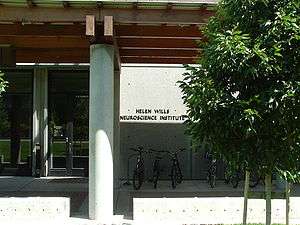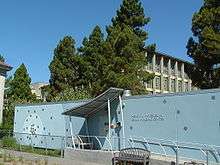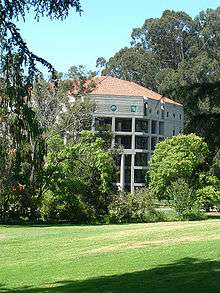Helen Wills Neuroscience Institute
The Helen Wills Neuroscience Institute (HWNI) at the University of California, Berkeley was founded in 1999 with assistance from a US$10 million bequeathal left by eight-time Wimbledon champion Helen Wills Moody, an alumna of the University of California - Berkeley.
History

After the death of Helen Wills Moody in 1998 the University of California, Berkeley approved the foundation of a new neuroscience research institute. In order to honor the contributions to the university by this alumna her name was made eponymous with the institute. In 1999 the institute officially became a part of the University, forming its own graduate school which offers a doctorate in neuroscience. The first student to receive a PhD in Neuroscience from the institute was Thomas Muench, PhD who graduated in 2005. At any time there are approximately 40 graduate students in the department, though there is no undergraduate neuroscience program.
The institute now encompasses over 40 research faculty from many departments including: Molecular & Cellular Biology, Psychology, Integrative Biology, Vision Science, Chemical Engineering, Electrical Engineering & Computer Science, Physics, Environmental Science, Policy & Management and Anthropology. The institute supports 5 general subdivisions within neuroscience: Cellular, Cognitive, Developmental, Molecular, and Systems.
Research centers
The Helen Wills Neuroscience Institute currently houses four research centers each with a unique focus on elucidating the functions of the brain.
Brain Imaging Center

The Henry H. "Sam" Wheeler, Jr. Brain Imaging Center (BIC) is led by Mark D'Esposito, MD. This facility houses one of the most powerful (and the most powerful at the time of its installation) human research functional Magnetic Resonance Imaging (fMRI) system in the United States. The 4 tesla magnet provides an opportunity for research collaboration in functional neuroimaging among diverse fields. Data are analyzed at the Judy & John Webb Neuroimaging Computational Facility also housed on the Berkeley campus.
Neurogenomics Center
The Neurogenomics Center is led by John Ngai, PhD. This facility creates and utilizes advanced gene chip and gene microarray technologies to examine brain function at the molecular, genomic level.
Molecular Imaging Center

The Molecular Imaging Center is led by Ehud Isacoff, PhD. This facility aims to image--at the molecular level--the dynamic properties of in vitro neurons by utilizing molecular optical reporters of neural function.
Redwood Center for Theoretical Neuroscience
The Redwood Center for Theoretical Neuroscience became a part of the HWNI on July 1, 2005 after the dissolution of the nonprofit scientific research facility, the Redwood Neuroscience Institute (RNI), once housed in Menlo Park, California. The RNI was established by Jeff Hawkins in August, 2002. Many of the researchers from the RNI joined the University as faculty or staff, and the institute was renamed the Redwood Center for Theoretical Neuroscience. Through the use of various electro- and magnetophysiological techniques, this group hopes to discover an underlying biological mathematics model of memory and cognition.
Affiliates
- Pierce College - HWNI offers a Summer neuroscience research program for Pierce undergraduate students to work with a student or faculty mentor on supervised research projects.
- Trinity College Institute of Neuroscience
Directors
- 1998-1999: Carla Shatz, Ph.D.
- 1999-2001: Corey Goodman, Ph.D.
- 2001-2011: Robert T. Knight, M.D.
- 2011-12/15/2013: John Ngai, Ph.D.
- 12/16/2013-present: Ehud Isacoff, Ph.D.
External links
Coordinates: 37°52′27″N 122°15′50″W / 37.874157°N 122.263925°W
